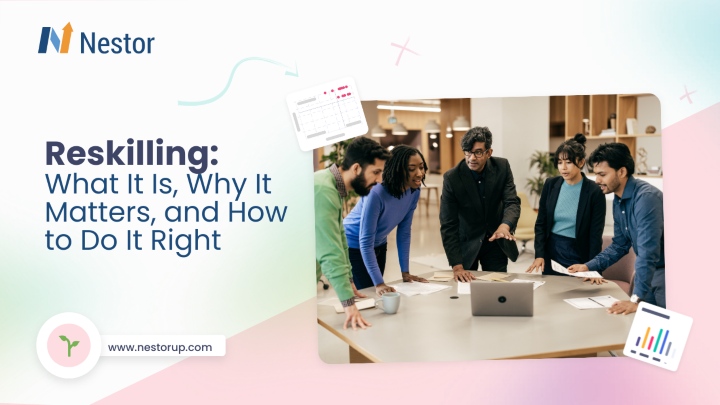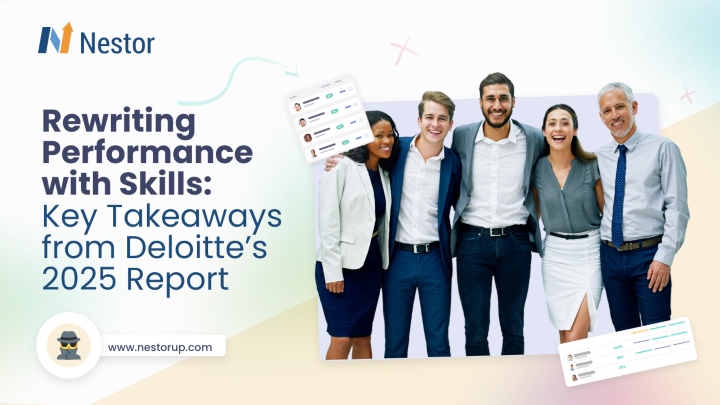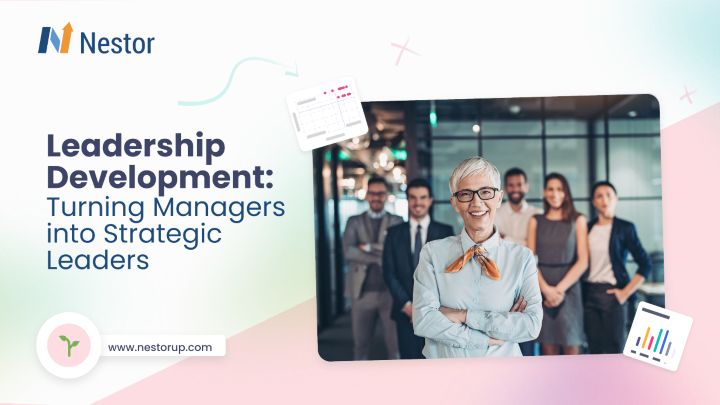How to Maximize Employee Potential: Strategies and Leadership Tips
9 min read

Being part of a highly competitive business landscape means modern organizations are constantly looking for ways to unlock the full potential of their workforce. And this responsibility often falls on the shoulders of HR professionals, L&D specialists, and people managers — who need to find answers to the question: how can we maximize the employee potential?
The solutions aren’t at all surprising or new, but the secret lies in the effective implementation of these strategies and combining a wider range of best practices to really help your people make the most out of their competencies and expertise.
For example, an employee skills profile — that unlocks in-depth skills visibility and insights (current and unknown abilities) — combined with regular data from 360 feedback (individual strengths and weaknesses) can represent an excellent starting point for discovering and then maximizing employee potential within your company. But what are the other strategies and methods?
Strategies for maximizing employee potential
Ensure the right people are in the right roles
It might be surprising, but there are enough situations in which employees are either in the wrong role or in one that doesn’t allow them to explore their entire skill set and know-how.
This can happen either because they have key skills that aren’t utilized (or under-utilized), or they have already outgrown their current position and are ready for the next step but haven’t made that move yet (or it isn’t available).
By constantly striving to match employees with new opportunities in all their forms — projects, cross-departmental initiatives, new roles — you create a work environment in which they can use precisely the skills that are in high demand, which leads to their potential being fully explored.
Get serious about career pathing
Career pathing is the strategic and thorough process of planning how employees can move from their current roles to their ultimate career goals within your organization — so, it’s easy to understand its critical role in supporting employee potential.
It serves as a solid structure for professional development and provides the clarity and transparency necessary for:
- setting specific development goals
- acquiring relevant skills
- gaining valuable work experience
- identifying the best-fit opportunities for advancement
A very important aspect of career pathing is the flexibility that it brings, which is very different from the traditional career ladder approach. In practice, this manifests as allowing employees to make lateral and cross-departmental moves, in addition to the common vertical ones.
This is relevant because, regardless of all the hiring and matching efforts, people with the right skills can end up in the wrong role. Or at least one that doesn’t allow them to explore the full depth of their skill set and potential. Lateral or cross-departmental transitions can solve that. And the benefits of career pathing don’t stop there. It can also:
- boost employee engagement, motivation, and overall morale
- improve their productivity and results
- reduce attrition
Learn more about career pathing and its importance.
Provide personalized learning and development (L&D) opportunities
Like career pathing, learning and development opportunities not only contribute to retaining employees but also help unlock their full potential.
By tailoring training programs and growth plans to individual needs and aspirations, organizations can invest in L&D resources that are more effective and enable people to develop applicable skills — creating a significantly improved learning experience and environment.
To identify those individual needs, you should look at skills-based approaches, which can transform the entire talent management process. In terms of L&D, you will be able to identify skill gaps and improvement areas more easily and accurately and match each employee and team with the best opportunity for their own growth needs.
Another way to boost the impact of L&D initiatives — and overall employee potential — is to stop relying only on traditional growth opportunities and embrace more modern and informal methods, including:
- temporary cross-departmental teams and projects
- mentoring and coaching (especially for people with leadership potential)
- learning in the flow of work
- peer-to-peer learning
- job shadowing
- job rotations
To further help employee potential materialize, organizations should also focus on upskilling or ensuring that your people have the necessary skills, competencies, and proficiency levels to perform at their best both now and in the future. Over time, this will also reduce the risk of emerging skill gaps or redundancy due to automation, for example.
Learn more about employee growth opportunities.
Shift to modern performance management systems
Another strategy that will help maximize employee potential within your organization is leaving behind traditional performance management systems — which are based on limited yearly reviews, inefficient communication, too focused on the past, and predisposed to recency bias.
These old systems may be able to assess overall performance (to some degree) but aren’t really driving growth. That’s where modern performance management comes in — a continuous process that prioritizes the development of desirable and in-demand skills, is future-focused, and relies on regular check-ins and feedback sessions.
Thanks to these periodic manager-employee discussions and interactions, people are encouraged and supported throughout their entire professional development journey and adjustments can be made timely whenever a certain L&D program isn’t working or new skill or growth needs emerge for a particular employee.
Learn more about modern performance management.
Foster a culture based on continuous learning and a growth mindset
Creating and maintaining a culture based on ongoing learning and a growth mindset is yet another way to maximize the potential of your workforce. And it all starts with:
- aligning personal development with organizational goals, so that all learning opportunities are relevant, effective, and mutually beneficial
- promoting and making learning a habit, which is all about encouraging curiosity, experimentation, and collaboration — qualities that need to be displayed by leaders and people managers as well
- making L&D opportunities transparent and easily accessible, something that can be greatly facilitated by an internal talent marketplace
- investing in the development of leaders and managers, who need to embrace a coaching style of leadership to better nurture employee potential
- listen to feedback from employees — feedback about the culture, learning opportunities, and other elements that determine both their growth and tenure at your company
Learn more about the benefits of a culture of continuous learning.
Recognize and reward achievements
Offering timely recognition and rewards to your people is essential for nurturing a supportive and positive work environment. And this shouldn’t be limited only to big achievements.
Even small wins should be celebrated and congratulated because they keep individuals and teams inspired and motivated to keep striving for more — which is, in essence, the basis of maximizing and fulfilling their potential.
Rewards and recognition can vary from simple verbal praise and employee of the month/quarter/year awards to gifts and social events, all displaying that your company is serious about showing appreciation for achievements.
How leaders can help maximize employee potential
Having looked at what can be done in terms of strategies and initiatives, let’s switch our focus to leaders and people managers and see what they can do to maximize employee potential.
Be a great mentor and a professional example in every sense
Demonstrating integrity, professionalism, and having a strong work ethic are all necessary to be perceived as a true example within the company. But to support the full potential of their team members, leaders need to consciously adopt the role of a mentor and make themselves available.
One aspect of this involves providing the necessary guidance and sharing tips and tricks to help each mentee progress in their own rhythm. Another is ensuring those you take under your wing avoid the pitfalls associated with their current or future roles — which is where personal experience and wisdom come into play.
Making yourself available for job shadowing programs or sessions is also important. Since some things associated with your role simply cannot be learned through other common interactions or L&D initiatives.
Of course, an integral part of supporting mentees and driving their growth is actually getting them to work on harder problems through stretch assignments. This will diversify their tasks and encourage them to step out of their comfort zone and tackle new types of projects for which they might not have all the necessary skills from the get-go.
Enhance emotional intelligence (EQ) and soft skills
Self-awareness and regulation, empathy, and social abilities — are integral parts of emotional intelligence and enable leaders to understand and manage their own emotions effectively, as well as to empathize and relate to other’s emotions.
Having strong soft skills is just as important since today’s interconnected and multicultural workplace relies on the ability to communicate ideas clearly, delegate tasks, and solve conflicts. Working on developing these abilities will help leaders be more impactful mentors. And another benefit is that by improving your own skills regularly, you will inspire others to do the same.
How Nestor can help maximize employee potential
Nestor is a skills-based talent management platform that leverages the full power of skills to drive workforce agility, high performance, and continuous growth — all fundamental elements of maximizing the potential of your employees.
Using skills as a single source of truth, our platform connects performance management, employee engagement, and career development, which leads to better data-based talent decisions that are always aligned with the ever-changing business priorities.
Thanks to our Talent Marketplace module, people in your organization can receive automatic and personalized L&D suggestions and see all the available projects, learning opportunities, and open roles — all in one place, transparent to everyone, and easily accessible.
Schedule a free demo to learn more about how Nestor can help your employees fulfill their true potential.
Frequently Asked Questions (FAQs) about employee potential
How do you identify employee potential?
Identifying employee potential is a multifaceted process that involves assessing someone’s performance, skills, attitude, behaviors, and their willingness to learn and grow over time.
What is a high-potential (HiPo) employee?
A high-potential employee is someone who has already demonstrated the capability, drive, and commitment to excel beyond the current expectations and requirements of their role. HiPo employees are capable and eager to take on greater responsibilities and have the potential to achieve exceptional performance on a regular basis.
How do you develop employee potential?
The strategies we’ve explored in this article can act like stepping stones in the process of developing employee potential. These include embracing strategic career pathing, tailoring L&D opportunities to individual growth needs, transforming performance reviews into a continuous future-focused process, creating a culture of continuous learning, and rewarding the achievements of your employees.










